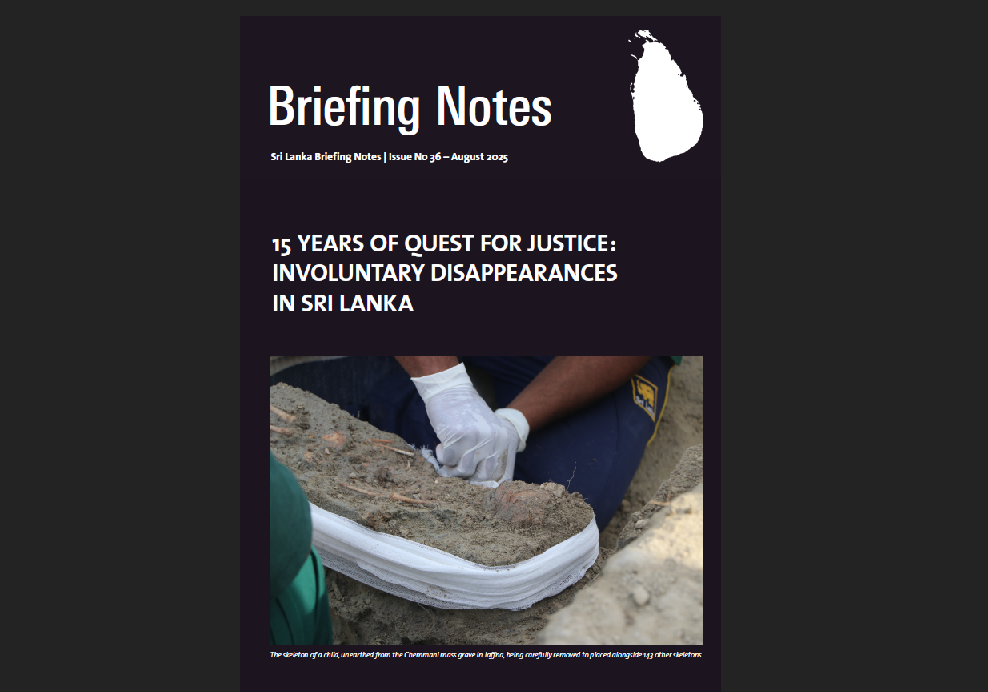Executive Summary
Over the past fifteen years[1], Sri Lanka has grappled with the haunting legacy of involuntary disappearances—an enduring human rights crisis rooted in decades of civil conflict, political repression, and systemic impunity. Tens of thousands of individuals, including civilians, activists, journalists, and combatants, vanished without trace during the height of the armed conflict between the Sri Lankan government and the Liberation Tigers of Tamil Eelam (LTTE). Among the most harrowing recent symbols of this tragedy is the Chemmani mass grave in Jaffna, where 144 skeletons—including that of three children —were unearthed, starkly illustrating the scale and brutality of enforced disappearances.
Despite repeated calls for accountability, successive governments have failed to deliver meaningful justice. Domestic mechanisms starting from ‘Lessons Learnt and Reconciliation Commission’ (LLRC -2012) to establishing the Office on Missing Persons (OMP – 2016) have made limited progress, often constrained by political interference, lack of resources, and inadequate legal frameworks. Families of the disappeared continue to face intimidation, delays, and emotional trauma, with many still holding onto photographs and memories in silent protest.
International responses have been more robust but uneven. The United Nations Human Rights Council (UNHRC) has passed multiple resolutions urging credible investigations and transitional justice measures. The UN Working Group on Enforced or Involuntary Disappearances has documented thousands of cases, while human rights organizations like Amnesty International and Human Rights Watch have consistently highlighted Sri Lanka’s failure to uphold its obligations under international law, including the International Convention for the Protection of All Persons from Enforced Disappearance, which Sri Lanka ratified in 2016.
Unfortunately, these resolutions, reports, and statements have not been met with constructive engagement by the Sri Lankan government except a brief period of the Good Governance government of 2015- 2019.
To break the cycle of impunity and restore dignity to victims and their families, this Briefing Note recommends:
- Establishing an independent, internationally monitored investigative mechanism with prosecutorial powers.
- Strengthening the mandate and capacity of the OMP to ensure transparency and victim-centered approaches.
- Enacting comprehensive legislation criminalizing enforced disappearances in line with international standards.
- Providing reparations, psychosocial support, and legal aid to affected families.
- Ensuring non-recurrence through security sector reform and human rights education.
The quest for justice is not merely a legal obligation—it is a moral imperative. With new Government in power Sri Lanka stands at a crossroads, the next steps will determine whether the country can truly reconcile with its past or remain trapped in its unresolved grief.
A credible, inclusive, and independent Truth and Reconciliation Commission (TRC) could offer a path forward by acknowledging victims’ suffering, uncovering the truth behind disappearances, and fostering national healing. Drawing lessons from international models such as South Africa and Sierra Leone, a Sri Lankan TRC must be survivor-centered, transparent, and empowered to recommend reparations and institutional reforms. Without such a mechanism, reconciliation efforts risk remaining superficial and fragmented.
[1] Although large-scale disappearances in Sri Lanka have persisted for over three decades, this Briefing Note focuses on the period since 2009, following the end of the civil war.
Read the full report as a PDF: SLB Briefing Note 36 – 15 years of quest for justice – Disappearances in SL
